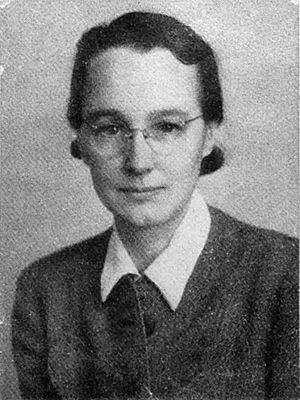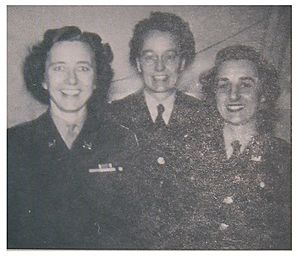Myrtle Bachelder facts for kids
Quick facts for kids
Myrtle Bachelder
|
|
|---|---|
 |
|
| Born |
Myrtle Claire Bachelder
March 13, 1908 |
| Died | May 22, 1997 (aged 89) |
| Education | Middlebury College (BS) |
| Known for | Chemistry of uranium and rare-earth elements |
| Scientific career | |
| Fields |
|
| Institutions | University of Chicago, Los Alamos National Laboratory |
Myrtle Claire Bachelder (born March 13, 1908 – died May 22, 1997) was an amazing American chemist and an officer in the Women's Army Corps. She is known for her secret work on the Manhattan Project, which developed the atomic bomb. She also created new ways to study the chemistry of metals.
Contents
Early Life and Education
Myrtle Claire Bachelder was born on March 13, 1908, in Worcester, Massachusetts. She loved learning science from a young age.
She earned a science degree from Middlebury College in 1930. After that, she taught science and coached sports at a high school in South Hadley Falls, Massachusetts. She later received her master's degree in education from Boston University.
World War II and the Atomic Bomb Project
During World War II, Bachelder joined the Women's Army Corps (WAC) in November 1942. After training, she received a top-secret assignment. She was to lead a group of 15 to 20 women from the WAC to Los Alamos, New Mexico.
This was part of the Manhattan Project, a secret military effort to develop an atomic weapon. Bachelder and her team arrived at Los Alamos on October 21, 1943. They lived in a special dorm, which is now a historic landmark.
Scientific Role in the Manhattan Project
At the secret Los Alamos National Laboratory, Bachelder had a very important job. She was in charge of analyzing uranium using a method called spectroscopy. This helped to check the purity of different types of uranium.
One type of uranium, uranium-235, can be split to create a huge explosion. Another type, uranium-238, cannot. Her work was vital to make sure the materials were pure enough for the world's first atomic bombs to work.
The methods she developed were also used to prepare plutonium-239. This material was used in the atomic bomb for the Trinity nuclear test on July 16, 1945. Similar methods were used for the uranium bomb, called "Little Boy", which was used on Hiroshima, Japan, on August 6, 1945. They were also used for the plutonium bomb that was used on Nagasaki, Japan, on August 9, 1945. These events led to the end of the war.
After the War: Nuclear Energy and Research
After World War II ended, the world entered a new "Atomic Age." Scientists began to explore how nuclear energy could be used peacefully. Bachelder was one of the scientists who disagreed with a bill that would have kept nuclear research under military control. This bill was later replaced by a law that put nuclear energy under civilian control.
In January 1947, the United States Atomic Energy Commission made 270 secret documents public. These included Bachelder's discoveries about X-radiation and how to purify uranium ore. At this time, her achievements as a woman in science were recognized as very rare and important.
Continued Scientific Contributions
After leaving the Army, Bachelder became a research chemist at the University of Chicago. This was where the first self-sustaining nuclear reaction had happened in 1942. She joined the university's Institute for the Study of Metals, which was later renamed the James Franck Institute. There, she continued her research in the chemistry of metals.
Bachelder also developed ways to purify rare elements like tellurium and indium. Her wide scientific knowledge was even used in marine archaeology. She helped figure out what ancient brass cannons found in the Aegean Sea were made of.
Later, NASA asked her to help with astrochemistry. She analyzed Moon rocks that had been brought back from the Moon during the Apollo missions between 1969 and 1972.
Bachelder retired from the Franck Institute in 1973. She then became active with the American Association of Retired Persons. She passed away in Chicago on May 22, 1997.
Myrtle Bachelder's Legacy
Bachelder believed that her work on the atomic bomb helped end World War II. She thought it prevented more lives from being lost in a longer conflict. Throughout her life, she loved to read and always challenged herself. She was known for working hard and making the most of every day.
See also
 In Spanish: Myrtle Bachelder para niños
In Spanish: Myrtle Bachelder para niños


